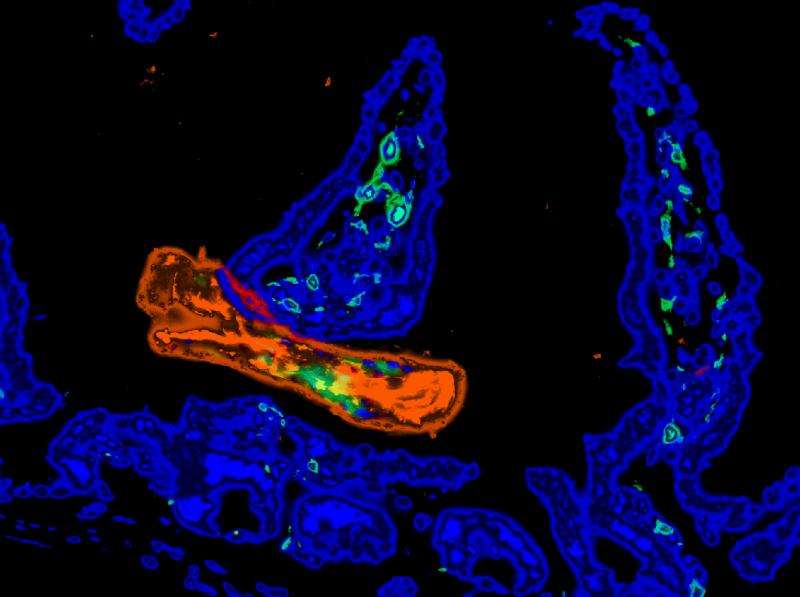Key protein that by protecting the body from damage in hookworm infections ensures benefits outweigh risks

Researchers in the School of Medicine at the University of California, Riverside have identified an immune protein in mice that is quickly triggered in the body following infection and serves to protect the body's tissues. Called "RELMalpha," this protein, whose homologue in humans is called "resistin," is responsible more for protecting the body than attacking the parasite.
As mammals, we have an immune system to fight pathogens that attack us. Because pathogens do us damage, the body naturally releases proteins to kill the pathogens. But these cytokines—proteins made by immune cells—can also attack the body's tissues and damage them. RELMalpha, made by mice to dampen the immune system response, focuses on protecting the body's tissues. Resistin is expected to function similarly in humans.
"This is counterintuitive," said Meera G. Nair, Ph.D., an assistant professor of biomedical sciences, whose lab led the research that focused on the hookworm as the parasite of study. "We think the immune system is all about killing the parasite. But that's not what RELMalpha sets out to do. It is important evidence that mammals have regulatory systems in place not to kill pathogens, but instead to dampen the immune response because this, overall, benefits the host."
Study results appear in the April 1 issue of the journal Infection and Immunity.
Hooked on worms
In her career, Nair has done considerable research on hookworms, soil-transmitted nematodes that infect an estimated 2 billion people worldwide—mostly in developing countries where sanitation is poor and people are often barefoot. After penetrating the skin, the hookworm—about 5 millimeters in length—travels from the bloodstream to the lung. Nair explained that the hookworm proceeds to damage the lung, the first organ it infects. When blood vessels break and hemorrhaging follows, the hookworm feeds on the blood (it cannot, however, survive in blood). When it is coughed up and swallowed, it then travels to the gut, the second organ it infects.
"The hookworm could not reach the gut if it didn't use the lung," Nair said. "In the gut, it releases thousands of eggs, which then go into the feces, completing the cycle. This is why infection is prevalent where lack of sanitation is also common, where, say, open defecation is practiced."
For their lab experiments, Nair's team used mice that were genetically deficient, meaning they lacked RELMalpha. The researchers then infected the mice with hookworms. The mice killed the worms but did not survive themselves, being unable to recover from the worm infection, which damaged their lungs.
When such genetically deficient mice were given a low dose of worms, the mice managed to kill the worms faster. But they incurred damage to their bodies. Were the mice to have RELMalpha, the researchers posit, their lung tissues would have been better protected.
Death versus worm burdens
"If you had a choice between having a parasite in your body or you dying from trying to kill it, you would choose to have the parasite live in your body," Nair explained. "Worm parasites are exceptionally good at that. They live with us for long periods without causing much damage. Essentially, a partnership is set up so that both the host and worm benefit. Worms, one of the most complex pathogens, have evolved to be the ideal parasite. They do not want you to die because that would mean they could not survive either. At doing this balancing act between inflammation and immunity, worms may be better than all other pathogens."
Nair noted that there are no vaccines available to fight worm infections. Unfortunately, distributing drugs for a disease that infects billions of people is costly and unfeasible, she said.
"RELMalpha appears to be the pivot on which the balance between inflammation and immunity is struck," she said. "This is likely true in humans as well, where resistin, the human equivalent of RELMalpha, is highly expressed in worm infections." The lab's next focus will be to investigate human resistin in this context.
More information: Gang Chen et al. Comparison of RELMα and RELMβ Single- and Double-Gene-Deficient Mice Reveals that RELMα Expression Dictates Inflammation and Worm Expulsion in Hookworm Infection, Infection and Immunity (2016). DOI: 10.1128/IAI.01479-15


















